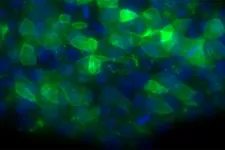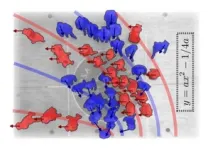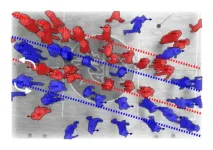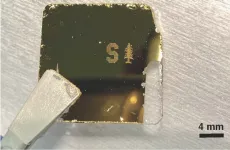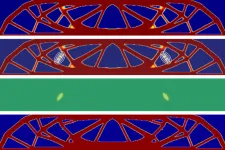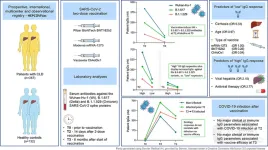(Press-News.org) Bone marrow is the spongy tissue inside bone responsible for making red blood cells, white blood cells and platelets. Bone marrow failure syndromes lead to an increased risk of developing dangerous infections, anemia and an increased risk of blood cancers.
Research led by Washington University School of Medicine in St. Louis has identified a possible treatment strategy for a rare bone marrow failure syndrome that is named poikiloderma with neutropenia. The work also may have implications for treating other bone marrow failure syndromes with similar underlying dysfunctions.
The research is published March 3 in the journal Science.
Poikiloderma with neutropenia is caused by mutations in a gene called USB1. Despite knowing the genetic error that causes the disease, the specifics of what the error does to cause bone marrow failure have long been a mystery. When the bone marrow fails, the body can’t make healthy red blood cells, white blood cells and platelets. People with these types of diseases are at increased risk of infections and are prone to developing skin and blood cancers.
“There are no cures for poikiloderma with neutropenia,” said co-senior author Luis Batista, PhD, an associate professor of medicine. “Patients are at high risk of dying from complications of infections, and scientists had no idea why mutations in this gene lead to bone marrow failure. In this new study, we found a novel role for an enzyme that opens the door to future clinical trials. There are investigational drugs that block this enzyme, so we are hopeful that clinicians who treat these patients may find this a promising strategy to pursue.”
Studying human embryonic stem cells engineered to model this syndrome, the investigators, including co-senior author Roy Parker, PhD, of the University of Colorado, Boulder, found a problem with the processing of molecules called microRNA. The processing problem causes specific microRNA molecules to break down faster than they should. Without sufficient levels of these microRNAs, the stem cells can’t develop into normal blood cells.
“Our study shows that normal USB1 is cutting off the long tails of these microRNAs, which stabilizes their structure, giving them time to do their jobs forming blood products,” said first author Hochang Jeong, PhD, a postdoctoral research associate in Batista’s lab. “When USB1 is mutated in this disease, these microRNA tails are much longer than they should be. We know that having longer tails makes microRNAs and other classes of RNA molecules more easily targeted for degradation. What we learned is there should be an equilibrium between the enzyme that puts the tails on and the enzyme that chops off the tails.”
While there is not yet a known way to restore the ability to properly remove the tails, investigational drugs already exist that block the enzymes responsible for putting the tails on. Blocking this enzyme in this disease potentially could restore the equilibrium between the adding and subtracting of tails.
The enzymes responsible for adding the tails are called PAPD5 and PAPD7, and inhibitors of these enzymes have been investigated in human clinical trials for other diseases, including hepatitis B. For this study, the researchers used a PAPD5 inhibitor called RG7834. Preventing the addition of the long tail stabilized the structure of the microRNAs, increasing their levels and restoring normal blood cell formation by these stem cells. The researchers are working with industry partners to develop new PAPD5 and PAPD7 inhibitors that are specifically designed to treat this and similar conditions.
“We are working with different companies to develop better and more specific PAPD5 inhibitors to treat this rare syndrome,” Batista said. “In my lab, we are big advocates for the study of rare diseases. Combined, rare diseases are not rare at all, and these patients deserve our attention. PAPD5 inhibition is poised to be a potential treatment for other bone marrow failure syndromes.”
###
This research was supported by the National Heart, Lung, and Blood Institute (NHLBI) of the National Institutes of Health (NIH), grant number 1R01HL137793-01; the Howard Hughes Medical Institute; the Department of Defense; the American Cancer Society; Siteman Cancer Center at Washington University School of Medicine in St. Louis; the Center for Regenerative Medicine at Washington University School of Medicine in St. Louis; and the National Research Foundation of Korea, grant number NRF-2021R1A6A3A03045808.
Co-senior authors Batista and Parker and two of their co-authors are inventors on a provisional patent filed by the University of Colorado, Boulder, that covers Usb1 as a target in leukemia.
Jeong H, Shukla S, Fok WC, Huynh TN, Batista LFZ, Parker R. USB1 is a miRNA deadenylase that regulates hematopoietic development. Science. March 3, 2023.
About Washington University School of Medicine
WashU Medicine is a global leader in academic medicine, including biomedical research, patient care and educational programs with 2,700 faculty. Its National Institutes of Health (NIH) research funding portfolio is the fourth largest among U.S. medical schools, has grown 54% in the last five years, and, together with institutional investment, WashU Medicine commits well over $1 billion annually to basic and clinical research innovation and training. Its faculty practice is consistently within the top five in the country, with more than 1,790 faculty physicians practicing at over 60 locations and who are also the medical staffs of Barnes-Jewish and St. Louis Children’s hospitals of BJC HealthCare. WashU Medicine has a storied history in MD/PhD training, recently dedicated $100 million to scholarships and curriculum renewal for its medical students, and is home to top-notch training programs in every medical subspecialty as well as physical therapy, occupational therapy, and audiology and communications sciences.
END
Possible treatment strategy identified for bone marrow failure syndrome
Researchers working with pharma collaborations to develop better treatments
2023-03-02
ELSE PRESS RELEASES FROM THIS DATE:
Stick to your lane: Hidden order in chaotic crowds
2023-03-02
Have you ever wondered how pedestrians ‘know’ to fall into lanes when they are moving through a crowd, without the matter being discussed or even given conscious thought?
A new theory developed by mathematicians at the University of Bath in the UK led by Professor Tim Rogers explains this phenomenon, and is able to predict when lanes will be curved as well as straight. The theory can even describe the tilt of a wonky lane when people are in the habit of passing on one side rather than the other (for instance, in a situation where they are often reminded to ‘pass on the right’).
This mathematical ...
Crowdsourced reports can quickly identify an earthquake’s impact
2023-03-02
Within minutes, a statistical model based on a global database of public reports of ground shaking can be used to identify an earthquake as a high- or low-impact event, according to a new study published in The Seismic Record.
High-impact earthquakes, as defined by the study, are those associated with at least one destroyed building, at least 50 damaged buildings, at least two deaths, or any documented financial losses.
The researchers were able to provide impact results for 393 global earthquake events from 2021 within 10 minutes. Their model was developed using more than 1.5 million globally collected felt ...
Ocean surface tipping point could accelerate climate change
2023-03-02
The oceans help to limit global warming by soaking up carbon dioxide emissions. But scientists have discovered that intense warming in the future could lessen that ability, leading to even more severe warming.
The discovery comes from a study led by The University of Texas at Austin in which researchers analyzed a climate simulation configured to a worst-case emissions scenario and found that the oceans’ ability to soak up carbon dioxide (CO2) would peak by 2100, becoming only half as efficient at absorbing the greenhouse gas by 2300.
The decline happens because of the emergence of a surface layer of low-alkalinity water ...
DRI announces space education trainings for Nevada teachers
2023-03-02
DRI is pleased to announce “Space Education Educator Professional Development Training,” available for 80 educators. The training will be conducted in Las Vegas and Reno by four Nevada educators who were selected to attend the NASA Space Exploration Educators Conference in Houston in February. In addition to touring NASA facilities, the conference provided hands-on training in lesson plans and activities, and these educators will use the knowledge they gained to teach Nevada teachers.
“DRI is pleased to offer NASA-approved space education training to ...
Stanford researchers develop a new way to identify bacteria in fluids
2023-03-02
Shine a laser on a drop of blood, mucus, or wastewater, and the light reflecting back can be used to positively identify bacteria in the sample.
“We can find out not just that bacteria are present, but specifically which bacteria are in the sample – E. coli, Staphylococcus, Streptococcus, Salmonella, anthrax, and more,” said Jennifer Dionne, an associate professor of materials science and engineering and, by courtesy, of radiology at Stanford University. “Every microbe has its own unique optical fingerprint. It’s like the genetic and proteomic code scribbled ...
Integrating humans with AI in structural design
2023-03-02
Modern fabrication tools such as 3D printers can make structural materials in shapes that would have been difficult or impossible using conventional tools. Meanwhile, new generative design systems can take great advantage of this flexibility to create innovative designs for parts of a new building, car, or virtually any other device.
But such “black box” automated systems often fall short of producing designs that are fully optimized for their purpose, such as providing the greatest strength in proportion to weight or minimizing the amount of ...
Foundation for anesthesia education and research establishes endowed NAM fellowship
2023-03-02
CHICAGO – The Foundation for Anesthesia Education and Research (FAER) announced it has established an endowed National Academy of Medicine (NAM) fellowship to provide early-career anesthesiology scholars with the opportunity to experience and participate in committee, workshop, and roundtable activities of NAM and the National Academy of Sciences (NAS).
Offering a robust catalogue of research grants and programs for early-career anesthesiology investigators, FAER – an American Society of Anesthesiologists’ foundation – is always exploring new avenues of support for up-and-coming researchers. The NAM Fellowship Program was recognized as one such ...
Liver cirrhosis is associated with a lower immune response to COVID-19 vaccines but not with reduced vaccine efficacy
2023-03-02
Amsterdam, March 2, 2023 – The overall responsiveness of patients with chronic liver disease (CLD) to COVID-19 vaccines has been shown to be decreased in patients with cirrhosis. A new prospective study in JHEP Reports, published by Elsevier, now shows that this lower response is observed up to six months following two-dose COVID-19 mRNA vaccination, but it does not reduce vaccine efficacy.
In this prospective study, more than 350 patients with CLD were recruited in clinical centers from Austria, Belgium, Italy, Portugal, Romania, and Spain. Cirrhosis, alongside age and vaccine ...
Human norovirus GII.4 exploits unexpected entry mechanism to cause gastroenteritis
2023-03-02
Human noroviruses are the leading cause of acute gastroenteritis worldwide, a major global health problem for which there are no specific treatments or vaccines. Understanding the first phase of infection – the process the virus follows to invade cells – is a decisive step in the development of effective preventive and therapeutic strategies. A team led by researchers at Baylor College of Medicine is making strides in that direction.
The researchers report in the journal Nature Communications that the globally dominant human norovirus GII.4 strain invades gastrointestinal cells via an unexpected mechanism. The viral strategy involves interactions ...
AI predicts cancer patient survival by reading doctor's notes
2023-03-02
A team of researchers from the University of British Columbia and BC Cancer have developed an artificial intelligence (AI) model that predicts cancer patient survival more accurately and with more readily available data than previous tools.
The model uses natural language processing (NLP) – a branch of AI that understands complex human language – to analyze oncologist notes following a patient’s initial consultation visit—the first step in the cancer journey after diagnosis. By identifying characteristics unique to each ...
LAST 30 PRESS RELEASES:
School meals could unlock major gains for human and planetary health
Menopause hormone therapy does not appear to impact dementia risk
Signature patterns of brain activity may help predict recovery from traumatic brain injury
Dresden study uncovers new key mechanism in cancer cells
New species are now being discovered faster than ever before, study suggests
Cannabis-based products show limited short-term benefit for chronic pain, with increased risk of adverse effects
Cannabis products with more THC slightly reduce pain but cause more side effects
Clearing the brain of aging cells could aid epilepsy and reduce seizures
Brain injuries linked with potential risk of suicide, new study finds
New technique lights up where drugs go in the body, cell by cell
New study finds movement of fishing fleets can reveal shifts in marine ecosystems
Embargoed: New evidence points to potential treatment for vascular dementia
Study uncovers disrupted brain balance in alcohol dependence
Working in groups can help Republicans and Democrats agree on controversial content moderation online
Structural findings reveal how distinct GPCR ligands create different levels of activation
Anything-goes “anyons” may be at the root of surprising quantum experiments
UC review: Maximizing workplace opportunity for veterans
From generation to complex control: Metasurfaces make perfect vortex beams "within reach"
Thin-film lithium niobate-based detector: recent advances and perspectives
Exploring why some people may tend to persistently make bad choices
How cells balance their protein levels
Nirsevimab vs RSVpreF vaccine for RSV–related hospitalization in newborns
Effectiveness and impact of maternal RSV immunization and nirsevimab on medically attended RSV in US children
AI gives scientists a boost, but at the cost of too many mediocre papers
Next-generation vision model maps tree growth at sub-meter precision
Genes aren’t destiny for inherited blindness, study shows
MIT study: High-fat diets make liver cells more likely to become cancerous
Exposure to multiple fine particulate matter components and incident depression in the US Medicare population
Risk of burdensome health care spending over time in the US
Nirsevimab against hospitalizations and emergency department visits for lower respiratory tract infection in infants
[Press-News.org] Possible treatment strategy identified for bone marrow failure syndromeResearchers working with pharma collaborations to develop better treatments
